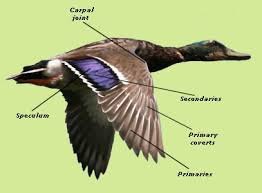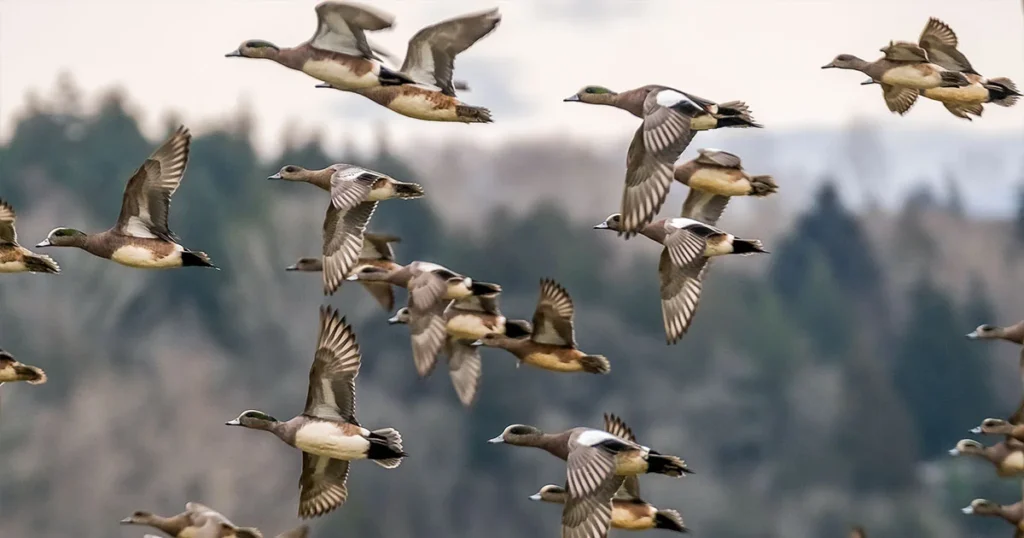Introduction to do ducks fly and Flight
Have you ever looked at the sky and asked yourself, “Do ducks fly?” These birds might seem simple enough, but they have a surprising secret. So, let’s take a trip to demystify duck flight and reveal seven incredible things that will leave you open-mouthed! Now, we stretch our wings and ascend to these air-borne creatures’ world.
The Anatomy of a Duck’s Wing

The anatomical make-up of ducks is intriguing, as it involves structures that enable them to navigate land and air. What makes the duck’s anatomy so fascinating is its wings.
A duck’s wing is an intricate blend of plumes, skeletons, flesh, and sinews that allow the bird to fly and rise. In the air, steering is controlled by the primary feathers located at the tip of the wing.
When ducks fly, their covert feathers protect them against cold weather and help streamline their bodies. The alula (also called the “bastard wing”) works like aircraft slats, minimizing turbulence along the leading edge of the wings.
Notably, ducks have strong pectoral muscles that flap their wings when flying. These muscles are underpinned by a sturdy skeletal system, allowing ducks to travel long distances effortlessly through the air.
How do Ducks Fly: The Mechanics Behind Their Flight
Ever wonder how the ducks can fly with such grace and ease? Let’s learn about the fascinating science behind duck flight.
They fly in the air because of their strong chest muscles, which hold and move their wings. Their wings are arranged during flight to ensure maximum lift and manoeuvrability.
Ducks use their wing power on takeoff to exert enough energy on air to rise from the earth’s surface. They flap one moment and glide another, thus achieving flying accuracy through the sky.
Due to their streamlined body contours and aerodynamic wings, these ducks can move at high speeds and go anywhere, whether in open water or dense forests.
If you ever see a duck soaring above your head or descending gently near a pond, please consider how intricate these incredible creatures are at dominating the skies effortlessly. Ducks, indeed, rule the sky!
Do All Ducks Fly?

It is not so easy to answer the question of whether all ducks can fly. But many types of ducks can fly, too.
A typical example of such a bird is the flightless steamer duck. These birds have evolved in places where flying is unnecessary for survival, so they have become more terrestrial and started using other means of movement.
However, most species of ducks are capable of flying. Their wings are highly adapted for air travel, thus enabling them to glide smoothly in the skies or speedily move over water surfaces. They engage in long migrations or search for food through flight.
Consequently, those that don’t occasionally show off excellent flying skills that still thrill birders worldwide.”
The Different Types of Flying Ducks
In the case of ducks flying, several types do different things when they fly. Some ducks, such as the Mallard, are known for their powerful and swift flight; they can cover long distances during migration. The Wood Duck is another type of duck with a less consistent flight pattern as it moves through wooded regions and wetlands.
On the other hand, the Canvasback can dive and take off from water quickly because it has strong wings. It usually demonstrates a fast, straight flight towards its feeding grounds.
On the contrary, dabbling ducks like Northern Pintail glide slowly across open waters or marshes, flapping with the same rhythm. These birds’ flights are very graceful, and they make smooth landings.
Furthermore, each flying duck possesses unique qualities that contribute to the diverse aerial abilities and behaviours seen in nature.
Exciting Facts About Duck Flight Patterns
It is mind-blowing to fathom that ducks can race and fly at 60 mph. It’s an eye-opener.
Their quick and graceful movements in the sky show how well they control themselves when flying.
Another exciting fact is that ducks often migrate long distances, flying in a V formation. This helps them save energy, as flying together creates aerodynamics.
Moreover, Ducks are also highly adaptable fliers capable of quickly turning and adjusting their flight path. They can move through different terrains, showing their capability to flit through the air.
In fact, watching ducks fly is absolutely amazing. They do so gracefully by gliding along naturally. So next time you see the flock of ducks floating above your head, take a moment to ponder the intricate patterns and sheer beauty involved.
Conclusion: Appreciating the Wonders of Duck Flight
Ducks are truly incredible animals that have mastered flight in their unique way. Their ability to fly gracefully and with agility through the air is spectacular. By understanding the anatomy and mechanics of duck flight, we can better appreciate how amazing these birds are.
Different species of ducks display different flying patterns as they migrate thousands of miles or drift silently across a peaceful lake. Not all ducks fly, but those show different flights as dictated by their species and behaviours.
From the powerful wing beats of a mallard to the synchronized formations of migratory flocks, every aspect of duck flight is exciting and worth our admiration! Think about how great it is that these beautiful birds take flight each time you see one soaring through the sky.
So next time you wonder, “Do Ducks Fly?” remember these seven cool facts about duck flights that will blow your mind away!
FAQs:
Q: Do ducks fly during migration?
A: Many ducks migrate long distances using mighty wings to reach breeding or wintering grounds.
Q: Can all types of ducks fly?
A: Nevertheless, flightless species like the steamer duck cannot fly; however, most ducks can fly to some extent.
Q: What adaptations do ducks fly have for flying?
A: Ducks have streamlined bodies, muscular chest muscles, and aerodynamic wings and feathers that aid in efficient flight.
Q: How do ducks fly, take off, and land while flying?
A: Ducks use powerful wing beats to take off from water or land and execute smooth landings by adjusting their wing positions.
Q: What are some fascinating behaviours displayed by ducks while flying?
A: Ducks exhibit synchronized flight patterns and agile manoeuvres, showcasing their adaptability and coordination in the air.
Q: Illuminating how the flight behaviours of ducks differ across species?
A: Different ducks fly differently; for example, there is that powerful, swift kind of flight in mallards and the graceful glide when dabbling for Northern Pintails.

